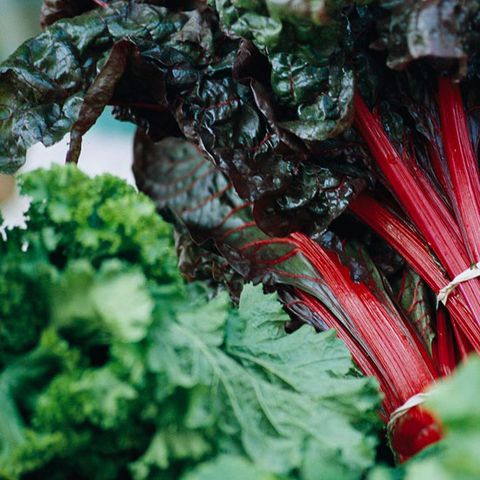Eat like Popeye with good-for-you greens, such as Swiss chard or spinach. Because greens cook down so much, we'll help you get the right amount to start.
All types of greens that are sturdy and leafy, such as chard, kale, mustard, beet, collard, and turnip greens, are known as cooking greens. They bring valuable nutrients to your diet and some flavor and color to your table. Besides collard greens, most cooking greens can be shredded and used raw in small amounts with other, more tender greens in a salad mix. However, these hearty types of greens are most commonly served cooked. So whether you're interested in how to cook mustard greens, how to cook kale greens, or other leafy veggies, we've got the basics of cooking greens covered.
How to Prepare Cooking Greens
As the name suggests, cooking greens are usually served cooked (though you can eat most of them raw), unlike other leafy veggies such as arugula and spring greens. Of course, you can still cook arugula and other noncooking greens (like bok choy), but they're not considered cooking greens.
Follow these two steps for cooking collard greens, turnip greens, beet greens, or any other type of greens. This basic method works for most greens and yields four servings. However, spinach is an exception. While you can boil it using the method below, cooked spinach is best when sautéed.
1. Prep the Greens
- Wash 12 ounces of greens in cold water. Drain well in a colander. Remove the stems by cutting them away with a sharp knife. Discard any bruised leaves.
- Tear the leaves into pieces. You should have about 12 cups total.
2. Cook the Greens
- Bring a small amount of lightly salted water to boiling in a Dutch oven. Add the greens.
- Cover the pan and cook until tender. Chard and beet greens will take 8 to 10 minutes; kale, mustard, turnip, and collard greens will take 15 to 20 minutes.
- Drain the greens well in a colander, pressing to remove excess liquid.
- If desired, toss with 1 tablespoon of butter or olive oil. Season to taste with salt and pepper.
Adding Flavor to Cooking Greens
For more flavor when you're cooking greens, consider these options.
- Use chicken broth for the cooking liquid instead of water.
- Add chopped onions, garlic, or bacon to the cooking liquid.
- Top cooked greens with crumbled crisp-cooked bacon.
- After cooking, sprinkle greens with balsamic or cider vinegar.
Different Types of Cooking Greens
If you can't decide between cooking beet greens and cooking kale, use this guide to help you pick out a type of green to pair with dinner. Here are the flavor profiles of some of the common cooking greens you're likely to find at the market.
- Beet Greens: Often red-veined, the leaves have a mild beet-like flavor, though larger leaves can be more pungent.
- Chard: Chard can be light to dark green, with stems in colors from white to pink to orange to red. It tastes a little like a cross between beets and spinach. Chard is often referred to as Swiss chard.
- Collard Greens: These thick, coarse, paddle-like leaves bring cabbage- and broccoli-like flavors.
- Dandelion Greens: These greens are tender, but their slender, sawtooth-edge leaves have a subtly bitter taste.
- Kale: This crinkly-leaf green has a strong peppery bite. You can find it in flowering, purple, common green, and white varieties.
- Mustard Greens: Expect a hot mustardy flavor in these light green leaves, though cooking can mellow the heat.
- Spinach: If you want a mild, sweeter flavor, look for baby spinach at the store – it'll also be less prep work since the stems are smaller and more tender than larger, mature spinach leaves.
- Turnip Greens: These greens impart peppery and mustardy zing, which becomes less pronounced after cooking.
Choosing and Storing Cooking Greens
While most cooking greens are available year-round, their peak season is from September to May.
- Look for leaves that are brightly colored with no sign of yellowing, wilting, or discolored spots.
- To store, cut away the center stalks of kale leaves (leave stalks on the other leaves). Refrigerate greens in plastic bags for up to five days; the exception is mustard greens, which you can refrigerate for up to a week.
Once you master cooking greens (and discover your favorite), serving them as a healthy side with dinner is easy. We're always looking for speedy, healthy side dishes for weeknight dinner, and cooked greens are an easy go-to. Plus, there are wide varieties, so you can mix it up each night by cooking collard greens one day, cooking beet greens the next, and switching it up every night of the week.
Fact checked by Marcus Reeves
This article was written by Sheena Chihak, RD from Better Homes and Gardens and was legally licensed through the DiveMarketplace by Industry Dive. Please direct all licensing questions to legal@industrydive.com.








